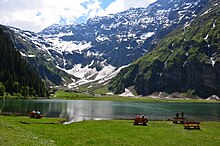| Location | |
|---|---|
 | |
| Location | Mittersill |
| State | Salzburg |
| Country | Austria |
| Coordinates | 47°13′33.53″N 12°29′19.36″E / 47.2259806°N 12.4887111°E / 47.2259806; 12.4887111 |
| Production | |
| Products | Tungsten |
| Production | 1,200 tonnes of tungsten |
| Financial year | 2009 |
| History | |
| Opened | 1967 |
| Owner | |
| Company | Wolfram Bergbau und Hütten |

The Mittersill mine (also known as Felbertal Mine) is a large mine located south of the Mittersill town, in the State of Salzburg in western Austria, 30 kilometres (19 mi) South of Kitzbühel and some 340 kilometres (210 mi) southwest of the capital, Vienna. Mittersill is the largest scheelite deposit in Europe, having in 2010 estimated reserves of 6.1 million tonnes of ore grading 0.5% pure tungsten. The mine produces around 500.000 t ore grading 0.3 %WO3, i.e., around 1,200 tonnes of WO3 per year (data from 2010 to 2017) .
History
The deposit was discovered in 1967, with production starting in an open pit mine in the eastern field in 1976. Since 1986 only underground mining in the western field is performed.
Geology and ore deposit genesis
The Mittersill deposit hosted in Early Palaeozoic metamorphic rocks, mainly in metabasites of the central Tauern Window, which were intruded by numerous granites during the Variscan orogeny (~340–290 Ma) and subsequently metamorphosed during the Alpine orogeny (~30 Ma). Scheelite is accompanied by pyrrhotite, pyrite, chalcopyrite, molybdenite, apatite and beryl; less common are minerals of the tungstenite‐molybdenite solid solution, marcasite, galena, arsenopyrite, sphalerite, pentlandite, magnetite and hematite. Several sulfosaltss, partly of bismuth occur too, as well as native bismuth.
The ideas on the genesis of the Mittersill scheelite deposit have strongly changed since its discovery. Whereas in the early days, mainly on the basis of its partly stratiform morphology, the deposit was interpreted as syngenetic and caused by submarine exhalative activity related to Early Paleozoic basaltic rocks, recent authors have accumulated evidences favoring an epigenetic ore formation by hydrothermal fluids derived from a Late Paleozoic granite.
References
- "Mittersill Scheelite deposit, Mittersill, Zell am See District, Salzburg, Austria". mindat. Retrieved 4 November 2023.
- ^ Ordosch, A., Raith, J.G., Schmidt, S., Aupers, K. (2019)Polyphase scheelite and stanniferous silicates in a W-(Sn) skarn close to Felbertal tungsten mine, Eastern Alps. In: Mineralogy and Petrology. vol. 13, p. 703–725
- "Mittersill". rhul.ac.uk. 2010. Archived from the original on 2011-08-15. Retrieved 2010-09-06.
- ^ "WBH History". Wolfram Bergbau und Hütten. Archived from the original on 2011-07-06. Retrieved 2010-09-06.
- ^ Raith, J.G., Schmidt, S., Aupers. K. (2018) Field Trip Pre-EX 5. Tungsten deposit Felbertal Salzburg, Austria. In: Berichte der Geologischen Bundesanstalt Band 126, 7–46
- "German mineral atlas". Retrieved 2017-02-02.
- Höll, R., Maucher, A., and Westenberger, H. (1972) Synsedimentary-diagenetic ore fabrics in the strata- and time- bound scheelite deposits of Kleinarltal and Felbertal in the Eastern Alps. Mineralium Deposita, v. 7, p. 217–226
- Höll, R. (1975) Die Scheelitlagerstätte Felbertal und der Vergleich mit anderen Scheelitvorkommen in den Ostalpen. In: Bayer. Akad. Wiss., math.-natw. Kl. Abh., N. F. 157 A-B, 1-157, 1975
47°13′34″N 12°29′20″E / 47.226°N 12.489°E / 47.226; 12.489
This Salzburg state location article is a stub. You can help Misplaced Pages by expanding it. |
This article about a specific mine is a stub. You can help Misplaced Pages by expanding it. |